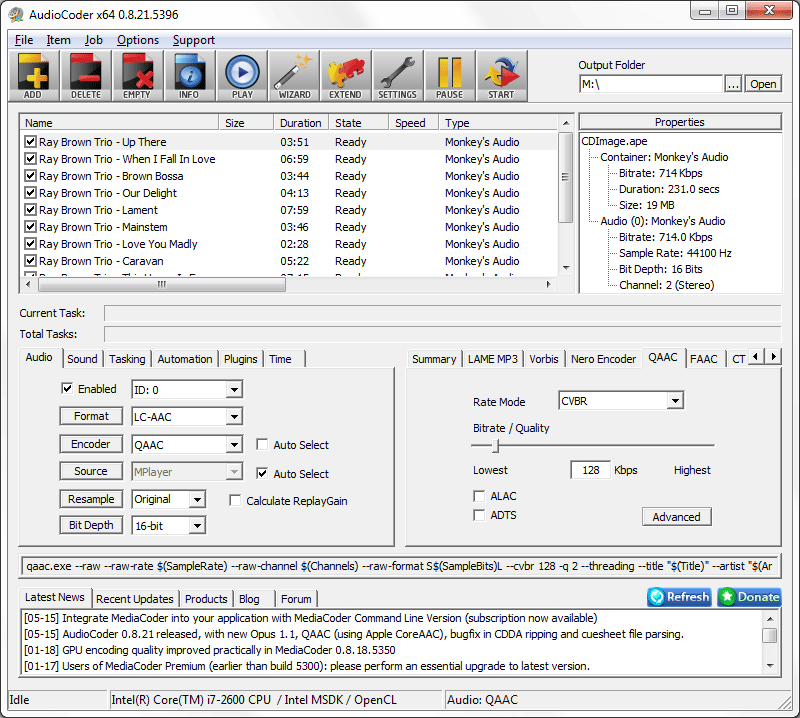

- MEDIACODER X64 JOIN FILES TASK MODE HOW TO
- MEDIACODER X64 JOIN FILES TASK MODE PORTABLE
- MEDIACODER X64 JOIN FILES TASK MODE FREE
- MEDIACODER X64 JOIN FILES TASK MODE WINDOWS
To do that, open the file soffice.ini located in the program’s folder with a text editor and change the Logo=1 to Logo=0. The splash screen shows absolutely nothing useful other than a progress bar so it is best to just disable it.
MEDIACODER X64 JOIN FILES TASK MODE FREE
OpenOffice is a free alternative of the paid Microsoft Office suite with applications such as Writer to replace Word, Calc to replace Excel, and Impress to replace PowerPoint. Simply right click at The Bat!’s shortcut, select properties, make sure that you’re at the Shortcut tab, and finally append a space with /nologo at the end after the double quotes. Launching the program each time will show a not really useful splash screen which fortunately can be easily disabled by adding a /nologo at the end of the shortcut’s target.

The Bat! is one of the most secure if not the most secure email client that is safe from vulnerabilities such as pFragments Microsoft Office exploit and Heartbleed bug in TLS.
MEDIACODER X64 JOIN FILES TASK MODE PORTABLE
All of the software made portable by PortableApps shows a splash screen which can be easily disabled by copying the program’s INI file from Other > Source folder to the root of the program’s folder, edit it with a text editor and change the DisableSplashScreen=false to DisableSplashScreen=true. You can find over 300 unofficial portable builds of software such as Notepad++, GIMP, IrfanView, FileZilla, Google Chrome, Mozilla Firefox, VLC Media Player, 7-Zip and etc in which are guaranteed to be safe from malware. Go to the Settings tab, expand User Interface and uncheck “ Show splash screen on startup“. Disabling the splash screen in JDownloader is quite easy. There is really nothing useful in JDownloader’s splash screen other than an animated progress bar. JDownloader is written in Java and there is a bit of delay for the graphical user interface to show when you run it.

Expand User interface, go to Graphics and uncheck “ Show splash-screen at startup“. To disable it, run the ESET program, click on Setup and click Enter advanced setup.
MEDIACODER X64 JOIN FILES TASK MODE WINDOWS
If you have a slow computer that takes quite a while to boot up Windows or perhaps you have a lot of programs in startup, you might want to disable the unnecessary ESET splash screen although it doesn’t really interfere when you start using the computer. The ESET splash screen is only shown once when the program is started when Windows is booted up. Note that doing this might or might not necessarily make the program load any faster. Here is a selection of nine popular applications where you can disable the splash screen if you have no use for it want it to be permanently removed from view. Other than that, we also introduce an interesting tool that can automatically detect and hide splash popups for certain programs.
MEDIACODER X64 JOIN FILES TASK MODE HOW TO
If you are one those that find splash screens unnecessary or useless, here we’ll guide you on how to disable the splash screen for some of the most popular applications. Some users also feel that the program loads slower if a splash screen is shown. Heavy software such as Adobe Photoshop or AutoCAD that takes quite a while to load might find having a splash screen useful to show the current status of the startup for troubleshooting purposes.Īs for other splash screens, they are there without a purpose and users are normally annoyed by them because the splash screen stays always on-top causing the user unable to see or access anything behind the splash popup window. Most of the time splash screens are implemented just to add some eye candy to the software to attract the user but very few really require it.

Not all software has splash screens as they only show up if the developer of the software decides to add it in. A splash screen is a popup window with a logo or image that normally appears at the center of the screen when you run a program.


 0 kommentar(er)
0 kommentar(er)
